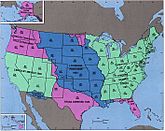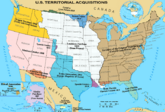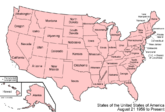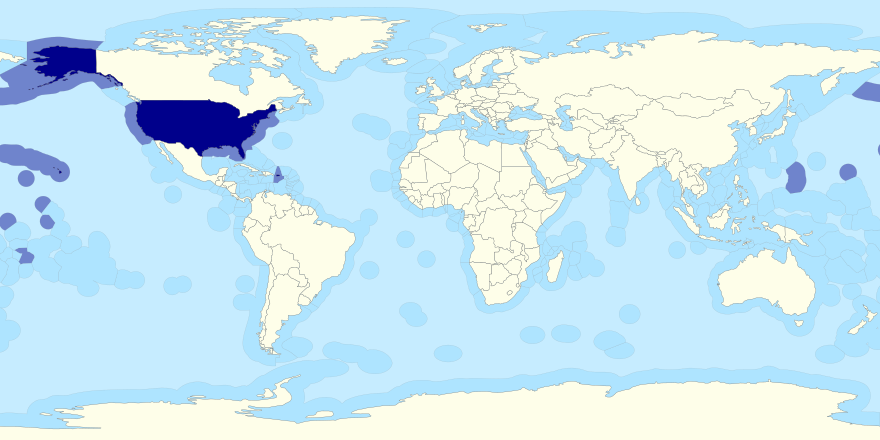U.S. territorial sovereignty facts for kids
The United States has different kinds of land areas. A territory is any area of land or water that is under the direct control of the U.S. federal government. This includes land far away from the main states, like islands. The U.S. government has the right to explore, use, protect, and manage these areas. The total territory of the United States includes all the places that belong to and are controlled by the federal government.
Contents
What is U.S. Territory?
The territory of the United States includes any place under the control of the U.S. federal government. This means different regions, districts, and divisions are managed by the federal government. It refers to specific areas of land, air, or sea where the U.S. government has authority. These areas belong to the United States and are used for managing the country and other purposes.
The U.S. Constitution and Territories
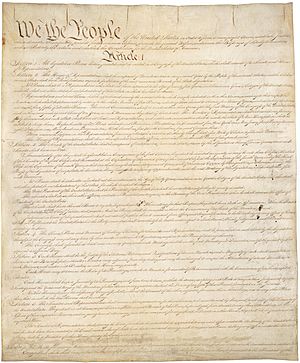
The U.S. Constitution talks about territories. It says that a territory belongs to the United States, even if it's not inside the main country or any specific state. This includes land or water areas that are not part of any state and have not become states yet.
The Constitution gives Congress the power to make rules for these territories. It says:
The Congress shall have Power to dispose of and make all needful Rules and Regulations respecting the Territory or other Property belonging to the United States; and nothing in this Constitution shall be so construed as to Prejudice any Claims of the United States, or of any particular State.
This means Congress can decide what happens to these territories and how they are governed.
Congress's Power Over Territories
Congress has the power to create governments for territories within the United States. This power comes from Article 4, Section 3 of the U.S. Constitution. One of the first times this power was used was with the Northwest Ordinance in 1789. Congress has strong and complete power over these territories, including creating different political areas, unless they give some power to the territory's own government.
The Supreme Court and Territory Laws
All areas controlled by the federal government are considered part of the "United States" when it comes to laws. The U.S. Supreme Court has made rulings about how the Constitution applies to territories. In the early 1900s, in cases called the Insular Cases, the Court said that the Constitution applies fully in some territories (like Alaska and Hawaii when they were territories). But in newer territories like Puerto Rico, Guam, and the Philippines, only parts of the Constitution applied.
A Supreme Court ruling from 1945 explained that the term "United States" can mean different things:
The term "United States" may be used in any one of several senses. It may be merely the name of a sovereign occupying the position analogous to that of other sovereigns in the family of nations. It may designate the territory over which the sovereignty of the United States extends, or it may be the collective name of the states which are united by and under the Constitution.
Managing Federal Lands and Territories
The United States Department of the Interior is in charge of managing federal matters within U.S. territory. This department has many jobs, including overseeing territorial governments and taking care of public lands. They also help with Indian reservations through the Bureau of Indian Affairs and with other territories through the Office of Insular Affairs. One special case is the Palmyra Atoll, an unorganized U.S. territory. Its local government and administration are managed by the Fish and Wildlife Service.
How the U.S. is Divided
States, Territories, and Local Areas
The main parts of the United States (the 48 connected states, Hawaii, and Alaska) are divided into smaller areas. Most states have counties, while Alaska has boroughs and Louisiana has parishes. A county can include many cities and towns, or just parts of them. These areas have different levels of political power. A township is a small geographic area, sometimes used for property records or as a local government unit.
The District of Columbia and other territories are directly controlled by Congress, but they are allowed to govern themselves in many ways. The U.S. government, not individual states or territories, handles foreign relations with other countries.
Some federal areas, like military bases and national parks, are managed directly by the federal government. In some cases, the federal government and the states share power over land that is part of a state but also has federal property.
History of U.S. Territories
In the past, territories were often set up with their own legislature (law-making body), a governor, and other officials chosen by the President. Historically, territories were either organized or unorganized. An unorganized territory usually had few people or was set aside for Native Americans. Today, "unorganized" means how much self-government a territory has.
After the Spanish–American War, the U.S. gained new territories like the Philippines, Puerto Rico, Guam, and Wake Island. The Supreme Court had to decide how these new areas, which were not meant to become states, would be treated. This led to the difference between incorporated and unincorporated territories.
- An incorporated territory is land that is fully part of the United States, and the entire U.S. Constitution applies there.
- An unincorporated territory is land owned by the U.S., but Congress decides which parts of the Constitution apply.
Today, the only incorporated U.S. territory is the unorganized and unpopulated Palmyra Atoll.
U.S. Insular Areas

The United States currently has 16 insular areas, which are islands or island groups that are U.S. territories:
- American Samoa
- Guam
- Northern Mariana Islands
- Puerto Rico
- United States Virgin Islands
- Minor Outlying Islands (a group of small islands)
The islands in italics are part of a dispute with Colombia, and the U.S. does not currently manage them.
Palmyra Atoll is the only incorporated territory left, and it has no government, so it's also unorganized. All the other insular areas are unincorporated territories of the United States. Puerto Rico and the Northern Mariana Islands are called commonwealths.
Dependent Areas
Some islands in the Pacific Ocean and Caribbean Sea are dependent territories of the United States.
The Guantanamo Bay Naval Base in Cuba is managed by the United States under a long-term lease. The U.S. also used to manage the Panama Canal Zone until 1999.
The United States has not claimed any land in Antarctica, but it has research stations there, like Amundsen–Scott South Pole Station. These stations are under U.S. control but are not considered sovereign territory because of the Antarctic Treaty.
Some countries, like the Federated States of Micronesia, the Republic of the Marshall Islands, and the Republic of Palau, are not U.S. territories but work closely with the U.S. under special agreements.
U.S. Maritime Territory
The U.S. government claims parts of the ocean next to its land and islands. This is based on the United Nations Convention on the Law of the Sea. This includes a 200-mile exclusive economic zone where the U.S. has special rights to explore and manage resources. The U.S. also extended its territorial waters from three to twelve nautical miles for national security.
The main group that enforces maritime law is the U.S. Coast Guard. Both federal and state governments share power over the waters owned by the country.
International Rules for U.S. Territory
International law does not stop the United States from making laws for its own territory. U.S. territory can sometimes include occupied territory, which is an area that the U.S. military controls, even if another country claims it. It can also include disputed territory, which is an area claimed by both the U.S. and another government.
Under international rules like the Hague Conventions of 1899 and 1907, if the United States Armed Forces control an area, it's considered U.S. territory. When the military controls an area, they are responsible for providing basic needs like food, shelter, and medical care to the people there. They also have to follow the laws that were in place before the occupation.
Customs Territories
The 50 states, the District of Columbia, and Puerto Rico make up the main customs territory of the United States. This means they follow the same rules for goods coming in and out of the country. Other areas like American Samoa, Guam, the Northern Mariana Islands, the U.S. Minor Outlying Islands, and the U.S. Virgin Islands have their own separate customs rules.
Other Areas of U.S. Control
The U.S. has control over the airspace above its land and territorial waters. There's no international agreement on where this airspace ends and outer space begins.
Federal areas like national parks and military bases are under federal control, even if they are located within a state. In some cases, the state and federal governments share power over these areas.
The U.S. also has control over its military installations, embassies, and consulates in foreign countries. These places are still part of the host country's territory, but the U.S. government has special authority there. For example, the U.S. owns land for memorials in places like England and France.
History of U.S. Federal Lands
After the American Revolution, the original states gave some of their land claims to the federal government. Laws like the Land Ordinance of 1785 helped survey and settle these lands. As the U.S. gained more land from countries like Spain and France, Congress made sure these lands were explored, surveyed, and made available for people to settle.
In the early 1800s, the General Land Office was created to manage these federal lands. Over time, laws were passed to allow people to buy or claim land, such as through homesteading. This system helped the U.S. expand across the continent.
In the 20th century, Congress started to manage public lands more closely, allowing for the leasing of resources like coal and oil. Today, federal lands make up about 640 million acres, which is about 28% of the total land area of the U.S.
See also
 In Spanish: Ámbito territorial de Estados Unidos para niños
In Spanish: Ámbito territorial de Estados Unidos para niños
- Territories of the United States
- Exclusive economic zone of the United States



